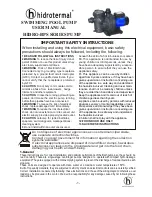
NEXGEN60 InstallationRev1
Page
4
of
42
04/11/2022
1.2 PRINCIPALS OF OPERATION
Production Tank Assembly
The production tank assembly consists of a polyethylene tank, four external electrolytic
cells, a circulation pump and heat exchanger. Pool water from the pool return line is fed
into the production tank. The circulation pump circulates water through the electrolytic
cells and heat exchanger. The water in the tank is maintained between 5000-ppm and
7000-ppm salt concentration. The electrolytic cells produce a 1666-ppm to 2500-ppm
sodium hypochlorite solution. The sodium hypochlorite flows to the pool at a flow rate of
3.3-gpm. The flow rate through the tank dictates the amount of sodium hypochlorite
produced. Sodium hypochlorite can be produced up to 72-gpd of equivalent chlorine.
The sodium hypochlorite flows to the pool for use in disinfection. The heat exchanger
has fresh pool water pumped through the coils to maintain tank temperatures of no more
than 10 degrees F above the pool water.
Dilution Fan
Electrochemical production of sodium hypochlorite produces hydrogen as a byproduct.
The dilution fan pumps fresh air into the production tank to dilute the hydrogen and force
it out the vent. The vent must be vented to outside atmosphere.
Saturated Salt Feeder
The saturated salt feeder supplies the production tank with a constant supply of salt to
produce sodium hypochlorite. Salt is used at the rate of 2 pounds per pound of equivalent
chlorine produced or 3 pounds per pound of equivalent chlorine produced depending on
production quantity selected. The saturated salt feeder is filled manually. Salt is pumped
using standard peristaltic chemical feed pumps.
Chemical Metering
Chemical metering is accomplished using a venturi. The flow through the venturi is
adjusted to provide the flow rate necessary to deliver the rated production of chlorine to
the pool.
Power Supply and Control Box
The power supply provides the current to the electrolytic cells to produce the rated amount
of sodium hypochlorite. The power supply houses all the safety features to prevent
system operation in the event of a malfunction.





































